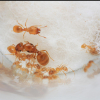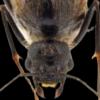HOLY @&$#% GUESS WHAT I JUST FOUND. I went blacklighting last night and (of course) turned up empty handed. I went back out this morning and walked through the middle of a tetramorium flight, but decided not to catch any. I then walked over to our tree that has a bunch of mulch around it and found some Lasius interjectus queens. At the last moment when I was about ready to leave, I looked over and saw a temnothorax worker. I bent down, and on closer inspection, I realized it was a Strumigenys sp., and not just that! It was a QUEEN! I confirmed this by spending 30 more minutes looking for a worker, which I eventually found one wondering about in the mulch. The queen is a lot larger than the worker and has a larger thorax! I’ll try and get some pictures later, BUT U LITERALLY can't DESCRIBE HOW HAPPY I AM.

Does anybody know how to raise these queens?
EDIT: I’m 80% sure this queen is S. pilinasis, I’ll get an ID thread going here soon.
Edited by CatsnAnts, June 19 2019 - 4:04 AM.


















